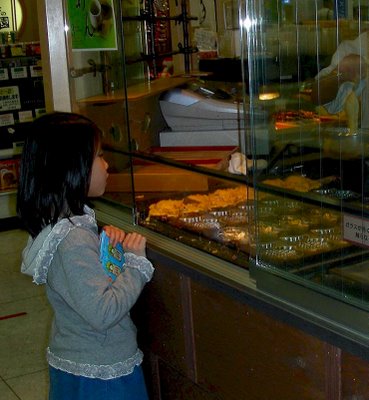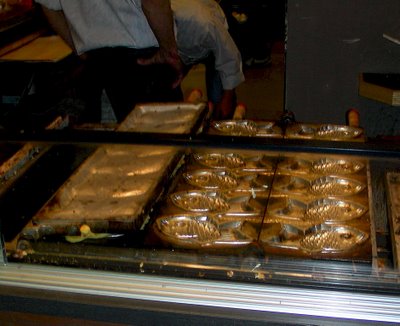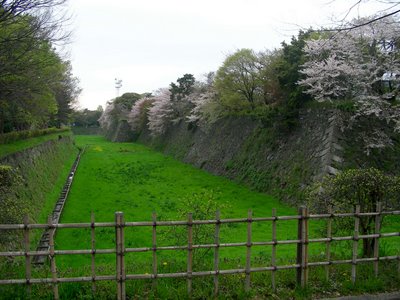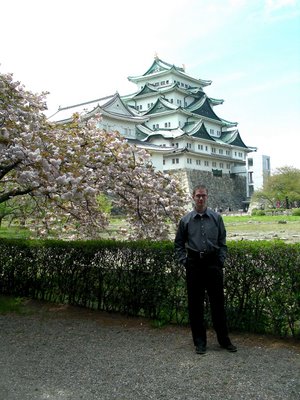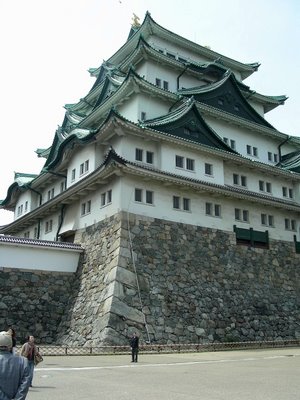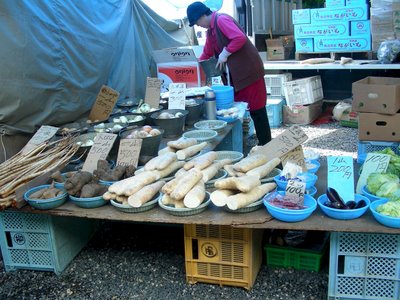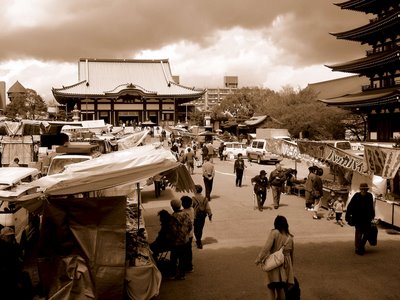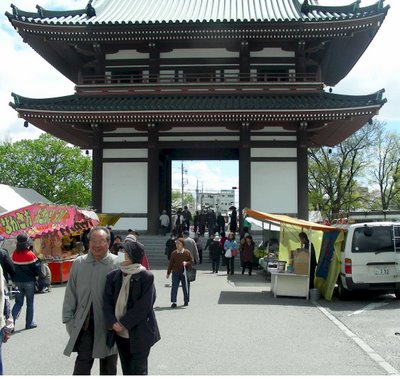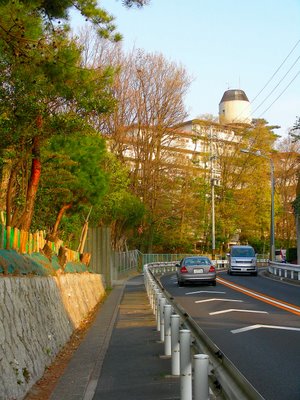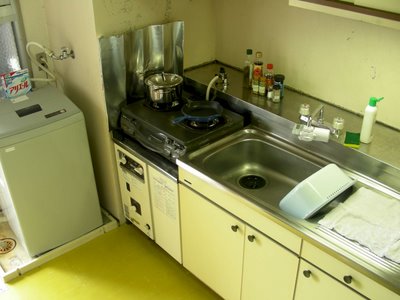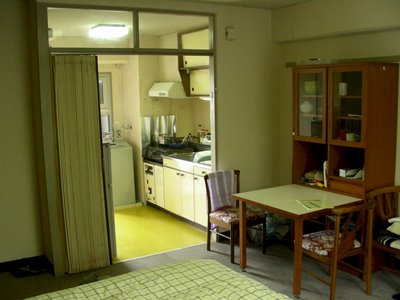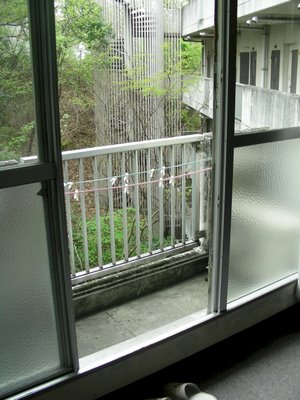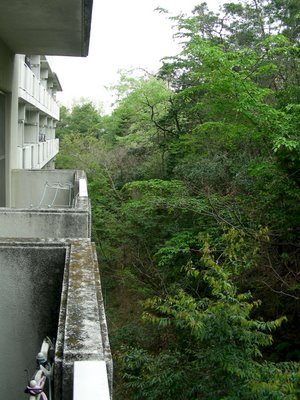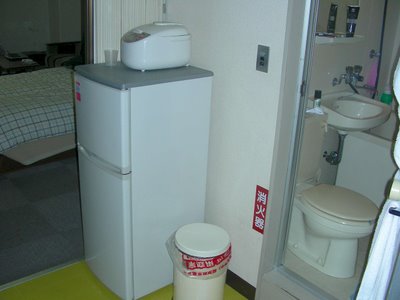There is a really amazing little temple called Toganji that is about a 10 minute walk from campus. It is about 500 years old and is this quite, peaceful little garden sanctuary tucked right into this dense urban environment. But first a few shots along the walk there...

This is just a regular house in traditional Japanese style that's in the neighborhood--I thought it was neat contrasted against the newer apartment building.
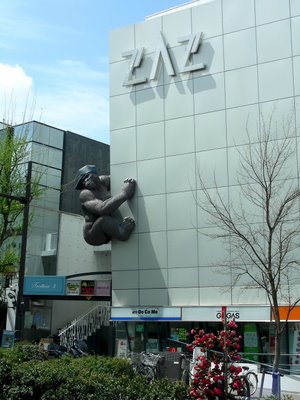
This is a giant monkey climbing on a building a few blocks up from Toganji--I thought Dad especially would appretiate this one!

This is basically a dollar-store that is directly across the street from the gate to Toganji. It's not just convenient--it's hyper-convenient! I'm not sure why this photo came out a wierd color, we're still figuring out our camera.

This is looking back out the main gate down the path towards the street, which already seems miles away. That's Caitlin.

This is one of the inner gates--the stone on the right is about 10 feet tall.
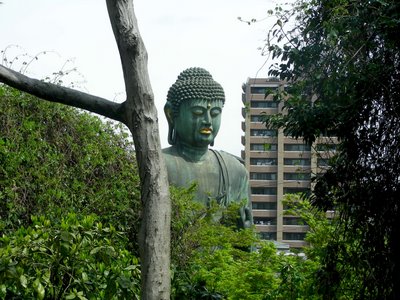
After you go through the inner gate (above) you get a glimpse of this daibutsu (giant Buddha) through the trees. It was quite startling the first time when you didn't know it was going to be there. It's down the hill from here and stands about 15 meters tall!

Standing at the base of the Toganji daibutsu. It is actually quite new, being completed in 1988.
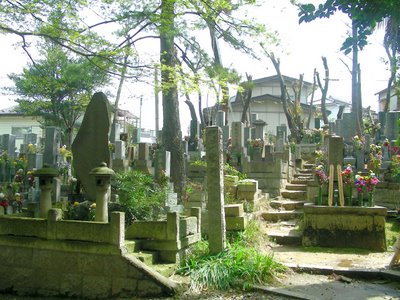
These are some of the gravestones (sort of family memorial plots) that are behind the temple area.
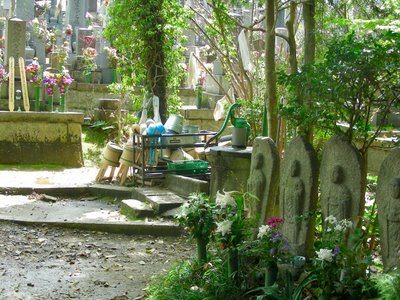
In this shot you can see the tools neatly arranged that people use to clean their family gravestone areas. We've taken walks here in the evenings a few times and you always see at least one or two people here cleaning their family graves.
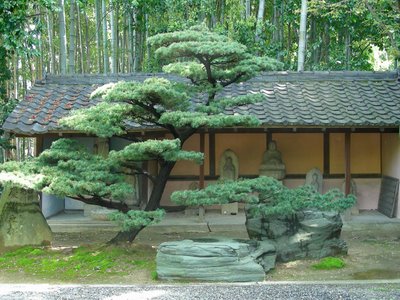
Here's an old pruned pine tree at Toganji. For a really complete description and history of Toganji with tons more pictures click
here. It is part of a web page prepared by Kikuko-san--one of the YWCA ladies who hosted a welcome tea for us at the Nagoya YWCA and who also helped Caitlin fill out her alien registration paperwork when she first got here. Click the "Top" button at the very bottom of her web-page to see the incredible depth and breadth of info on Nagoya that she has put together to help international students like us! She is just one of the many people who have been really great and helped us out just to be nice and be helping some one. For instance, the local Lion's Club donated the textbooks for my "Family of International Students Japanese Language Class." I thought that was neat because the Lion's Club in Willard, Missouri helped sponsor my little league baseball!
 Here's a clear shot of the 'koto'--they are plucked with one hand and the other hand can press down on the strings, sort of a cross between a mountain dulcimer and a harp. These were usually played several in unison, with one (usually the lady in front) taking a lead.
Here's a clear shot of the 'koto'--they are plucked with one hand and the other hand can press down on the strings, sort of a cross between a mountain dulcimer and a harp. These were usually played several in unison, with one (usually the lady in front) taking a lead.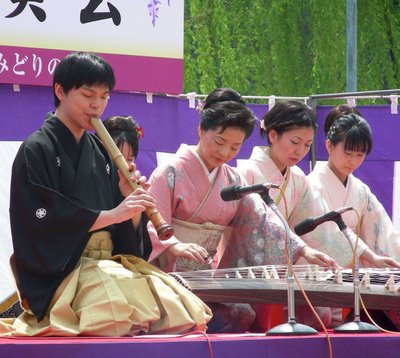 Here's a shot of the 'shakuhachi' player. The shakuhachi is the traditional bamboo flute. It's played by blowing just over one edge of the open top of the tube. All other flutes are played by directing the air across a hole in the side of the tube. Even pan-pipes are played by blowing across the top of the tube opening. As far as I know, only the shakuhachi is played by blowing down onto only one side of the tube. They're really hard to play and take incredible breath control. The guy playing in the picture is really young to be as good as he was (which was very good!). They said he made his public debut when he was 14, and was in his twenties now.
Here's a shot of the 'shakuhachi' player. The shakuhachi is the traditional bamboo flute. It's played by blowing just over one edge of the open top of the tube. All other flutes are played by directing the air across a hole in the side of the tube. Even pan-pipes are played by blowing across the top of the tube opening. As far as I know, only the shakuhachi is played by blowing down onto only one side of the tube. They're really hard to play and take incredible breath control. The guy playing in the picture is really young to be as good as he was (which was very good!). They said he made his public debut when he was 14, and was in his twenties now. These two women are playing 'shamisen'. They are sort of like three-stringed fretless banjos, but played with things that look like ice-scrapers. They can have a looser, more slidy sound than the koto.
These two women are playing 'shamisen'. They are sort of like three-stringed fretless banjos, but played with things that look like ice-scrapers. They can have a looser, more slidy sound than the koto. You can see the Castle in this shot. The stage was just across the moat from the back of the castle.
You can see the Castle in this shot. The stage was just across the moat from the back of the castle.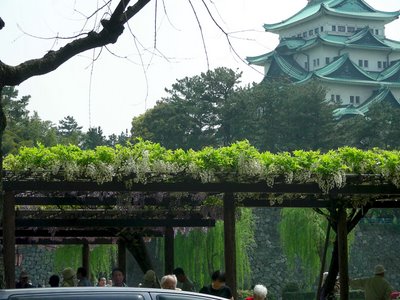 Here's a shot from farther back where you can see the Castle and the hanging wisteria (called fuji) which were just blooming. The concert was from 1:00 to 2:00 so it was pretty hot sitting in the full sun, but under the arbor it was nice and cool and the wisteria smelled really good.
Here's a shot from farther back where you can see the Castle and the hanging wisteria (called fuji) which were just blooming. The concert was from 1:00 to 2:00 so it was pretty hot sitting in the full sun, but under the arbor it was nice and cool and the wisteria smelled really good.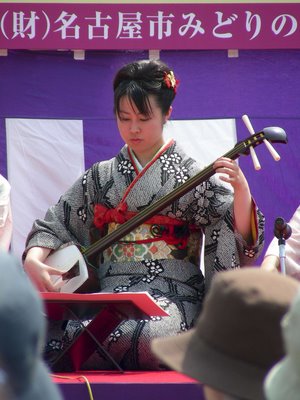 Another shamisen player. Here is a link to an Amazon CD listing where (if you scroll down a little) you can listen to samples of music like what they were playing.
Another shamisen player. Here is a link to an Amazon CD listing where (if you scroll down a little) you can listen to samples of music like what they were playing. I couldn't resist this 'funny English' shot of a bike parked at the concert. The name of the bike is 'potato'...
I couldn't resist this 'funny English' shot of a bike parked at the concert. The name of the bike is 'potato'...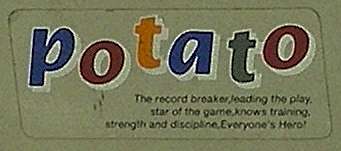 It says "The record breaker, leading the play, star of the game, knows training, strength and discipline. Everyone's Hero! Potato"--don't ask me why.
It says "The record breaker, leading the play, star of the game, knows training, strength and discipline. Everyone's Hero! Potato"--don't ask me why.

